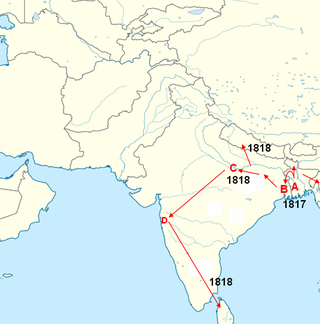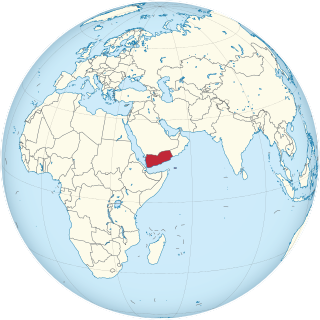A pandemic is a global epidemic or disease outbreak.
Contents
Pandemic may also refer to:
A pandemic is a global epidemic or disease outbreak.
Pandemic may also refer to:

Cholera is an infection of the small intestine by some strains of the bacterium Vibrio cholerae. Symptoms may range from none, to mild, to severe. The classic symptom is large amounts of watery diarrhea that lasts a few days. Vomiting and muscle cramps may also occur. Diarrhea can be so severe that it leads within hours to severe dehydration and electrolyte imbalance. This may result in sunken eyes, cold skin, decreased skin elasticity, and wrinkling of the hands and feet. Dehydration can cause the skin to turn bluish. Symptoms start two hours to five days after exposure.

A pandemic is an epidemic of an infectious disease that has spread across a large region, for instance multiple continents or worldwide, affecting a substantial number of individuals. A widespread endemic disease with a stable number of infected individuals is not a pandemic. Widespread endemic diseases with a stable number of infected individuals such as recurrences of seasonal influenza are generally excluded as they occur simultaneously in large regions of the globe rather than being spread worldwide.

An epidemic is the rapid spread of disease to a large number of hosts in a given population within a short period of time. For example, in meningococcal infections, an attack rate in excess of 15 cases per 100,000 people for two consecutive weeks is considered an epidemic.
Plague or The Plague may refer to:
Resistance may refer to:
Corona most commonly refers to:
An epidemic is a disease that spreads rapidly.

The first cholera pandemic (1817–1824), also known as the first Asiatic cholera pandemic or Asiatic cholera, began near the city of Calcutta and spread throughout South Asia and Southeast Asia to the Middle East, Eastern Africa and the Mediterranean coast. While cholera had spread across India many times previously, this outbreak went further; it reached as far as China and the Mediterranean Sea before subsiding. Millions of people died as a result of this pandemic, including many British soldiers, which attracted European attention. This was the first of several cholera pandemics to sweep through Asia and Europe during the 19th and 20th centuries. This first pandemic spread over an unprecedented range of territory, affecting almost every country in Asia.

The second cholera pandemic (1826–1837), also known as the Asiatic cholera pandemic, was a cholera pandemic that reached from India across Western Asia to Europe, Great Britain, and the Americas, as well as east to China and Japan. Cholera caused more deaths, more quickly, than any other epidemic disease in the 19th century. The medical community now believes cholera to be exclusively a human disease, spread through many means of travel during the time, and transmitted through warm fecal-contaminated river waters and contaminated foods. During the second pandemic, the scientific community varied in its beliefs about the causes of cholera.

The third cholera pandemic (1846–1860) was the third major outbreak of cholera originating in India in the 19th century that reached far beyond its borders, which researchers at University of California, Los Angeles (UCLA) believe may have started as early as 1837 and lasted until 1863. In the Russian Empire, more than one million people died of cholera. In 1853–1854, the epidemic in London claimed over 10,000 lives, and there were 23,000 deaths for all of Great Britain. This pandemic was considered to have the highest fatalities of the 19th-century epidemics.
The fourth cholera pandemic of the 19th century began in the Ganges Delta of the Bengal region and traveled with Muslim pilgrims to Mecca. In its first year, the epidemic claimed 30,000 of 90,000 pilgrims. Cholera spread throughout the Middle East and was carried to the Russian Empire, Europe, Africa, and North America, in each case spreading via travelers from port cities and along inland waterways.

The fifth cholera pandemic (1881–1896) was the fifth major international outbreak of cholera in the 19th century. It spread throughout Asia and Africa, and reached parts of France, Germany, Russia, and South America. It claimed 200,000 lives in Russia between 1893 and 1894; and 90,000 in Japan between 1887 and 1889. The 1892 outbreak in Hamburg, Germany was the biggest European outbreak; about 8,600 people died in that city. Although many residents held the city government responsible for the virulence of the epidemic, it continued with practices largely unchanged. This was the last serious European cholera outbreak of the century.

The sixth cholera pandemic (1899–1923) was a major outbreak of cholera beginning in India, where it killed more than 800,000 people, and spreading to the Middle East, North Africa, Eastern Europe, and Russia.

The seventh cholera pandemic is the seventh major outbreak of cholera and occurred principally from the years 1961 to 1975; but the strain involved persists to the present. WHO and some other authorities believe this should be considered as an ongoing pandemic. As stated in its cholera factsheet dated 30 March 2022, the World Health Organization (WHO) continues to define this outbreak as a current pandemic, and with cholera having become endemic in many countries. In 2017, WHO announced a global strategy aiming to end this pandemic by 2030.
A virus is a submicroscopic infectious agent that replicates only inside the living cells of an organism.

Seven cholera pandemics have occurred in the past 200 years, with the first pandemic originating in India in 1817. The seventh cholera pandemic is officially a current pandemic and has been ongoing since 1961, according to a World Health Organization factsheet in March 2022. Additionally, there have been many documented major local cholera outbreaks, such as a 1991–1994 outbreak in South America and, more recently, the 2016–2021 Yemen cholera outbreak.

A cholera pit was a burial place used in a time of emergency when the disease was prevalent. Such mass graves were often unmarked and were placed in remote or specially selected locations. Public fears of contagion, lack of space within existing churchyards and restrictions placed on the movements of people from location to location also contributed to their establishment and use. Many of the victims were poor and lacked the funds for memorial stones, however memorials were sometimes added at a later date.

Diseases and epidemics of the 19th century included long-standing epidemic threats such as smallpox, typhus, yellow fever, and scarlet fever. In addition, cholera emerged as an epidemic threat and spread worldwide in six pandemics in the nineteenth century. The third plague pandemic emerged in China in the mid-nineteenth century and spread worldwide in the 1890s.

An outbreak of cholera began in Yemen in October 2016. The outbreak peaked in 2017 with over 2,000 reported deaths in that year alone. As of November 2021, there have been more than 2.5 million cases reported, and more than 4,000 people have died in the Yemen cholera outbreak, which the United Nations deemed the worst humanitarian crisis in the world at that time. However, the outbreak has substantially decreased by 2021, with a successful vaccination program implemented and only 5,676 suspected cases with two deaths reported between January 1 and March 6 of 2021.